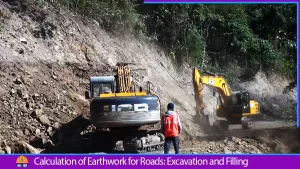Introduction
Earth excavation is one of the operations involved in civil engineering and construction projects. The scope of tasks can be minimal or maximal depending on the type of construction project. Earthwork for construction typically accounts for 6% to 20%. Most earthwork occurs during the construction of buildings and roads in hilly areas. The excavation also includes cutting rock.
Types of Earth Excavation and Measurement
As per Indian standards, there are several types of earth excavation works which are as follows:
Surface Dressing
Surface dressing is not exactly earth excavation work, but it may involve minimal earth-dressing work. A depth of not more than 150 mm is called surface dressing. The task primarily involves trimming natural ground, removal of vegetation, cutting and filling.
Measurement:
The surface dressed area is measured in square meters.
Surface Excavation
Earth excavation exceeding 1.50 m in width and 10 m2 on plan but not exceeding 30 cm in depth shall be called ‘surface excavation’.
Measurement:
The surface excavation is measured in square meters.
Also, read: Types Of Estimates in Construction Projects
Rough Excavation
The excavation not requiring dressing of sides and bottom and reduction to exact levels, such as winning earth from borrow pits, hillside cutting, etc. shall be described as rough excavation.
Measurement:
The rough excavation is done in cubic meters.
Excavation Over Area
Excavation exceeding 1.50 m in width as well as 10 m2 on the plan, and 300 mm in depth shall be described as excavation over areas and measured in cubic metres.
Also, read: What is Rate Analysis in Construction? | Analysis of Rate
Excavation in Trenches
Excavation in trenches for foundations and for pipes, cables, etc., not exceeding 1.50 m in width and for shafts, wells, cesspits and the like not exceeding 10 m2 on the plan shall be so described and measured in cubic metres.
The authorized quantities ( calculated on the basis of authorized width ) or those excavated whichever are less shall be measured in case of excavation for pipes, cables, etc. For the purpose of calculating the contents, cross-sections shall be taken at suitable intervals. The authorised width shall be specified in each case. ( Relevant Indian Standards, if any, may be consulted for guidance ).
- Excavation in Trenches for Foundation
Earth excavation for depth exceeding 1 m, an allowance of 50 mm/m depth for each side of the trench shall be added to the specified width.
- Excavation in Trenches for Post Host
Independent post holes ( or similar holes ), each not exceeding 0.5 m3, shall be enumerated and the description shall include return, fill and ram and removal of surplus spoil.
- Return, Fill and Ram
Returning, filling and ramming of excavated earth were not described with the item of excavation shall be measured in cubic metres and shall include spreading in layers not exceeding 200 mm in depth, watering, well ramming and levelling.
- Embankments
Forming embankments and filling to make up levels shall be measured in cubic metres and shall include the formation of slopes. If the material is to be deposited in layers, this shall be described stating the thickness of such layers. The method of consolidation shall be described. The measurement
shall be taken in successive stages of 1.50 m stating the commencing level. In the case of special soils like marine clay, the allowance for change in the original levels due to a load of an embankment shall be specified.
Filling under floors shall be measured in cubic metres and shall include spreading in layers not exceeding 200 mm in depth watering, well ramming and levelling.
Also, read: Embankment Construction: Materials And Specification
References:
- Bureau of Indian Standards. IS 1200-1:1992. Methods of Measurement of Building and Civil Engineering Works. (Part – 1, Earthwork). New Delhi, 110002. https://law.resource.org/pub/in/bis/S03/is.3764.1992.pdf
- Dutta, B.N. (2011). Estimating and Costing in Civil Engineering (26th Revision). UBS Publisher’s Distributors Pvt. Ltd.
![]()







